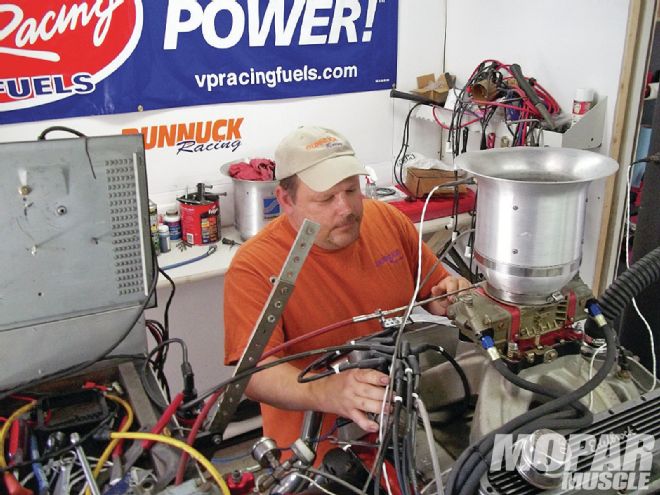
In recent years, we have heard of many enthusiasts having ignition control module failures. Most of these complaints come from the plug-in replacement "Orange Box." When reading through most any Mopar related forum, looking for an upgrade, the usual answer is a Mopar "Chrome Box."
Now we have another option that allows you to simply plug in a performance unit, and it comes with a nice added feature of a rev limiter to protect your engine. Named the Rev-n-Nator, this unit uses your same factory wiring harness and stock mounting location. It comes available powdercoated in black for a stock look, or orange to appear similar to the Mopar Performance box we are used to seeing. The Rev-n-nator is a true plug and bolt-in (almost) factory appearing I.C.M. (AKA: Brain Box). What makes it better is that it has been completely re-engineered with digital technology! And since we said almost factory appearing, we have to make mention that it has a simple to use built-in rev limiter that is visible on the outside. The rev limiter is not visibly detracting, but it will let anyone know that it's not a stock unit.
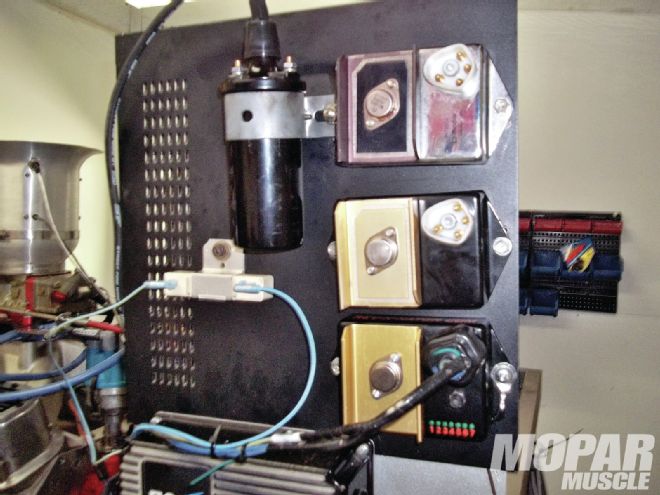 Making all tests consistent, we mounted the three ignition boxes to a panel and simply moved the plug as needed.
Making all tests consistent, we mounted the three ignition boxes to a panel and simply moved the plug as needed.
The rev limiter has seven different rpm limits ranging from 3,000 to 7,500 rpm. The limit required can be changed by a simple touch of the button that's on the face of the box. You'll know what rpm you have selected by the easy to read LED lights!
To protect your engine from over revving, the Rev-n-Nator is the perfect bolt-in piece to keep your engine from developing an unnecessary ventilation hole. There are no extra wires or boxes required, and it is a true bolt-in and go unit. This is not just some rebuilt unit either. It features all-new digital electronics, but it is in a stock box.
We recently had the opportunity to compare one of these Rev-n-Nator boxes against several other plug-in replacements, and comparing the different boxes against each other on an engine dyno allows us to see if there truly is a loss or gain between them that might go unnoticed on the street or even at the dragstrip. While traction, weather, convertor slip, etc. can come into play, dyno testing in a controlled environment can reveal some things that might go unnoticed otherwise.
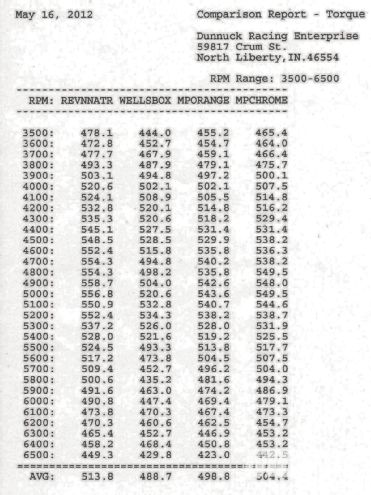 Torque
Torque
We did our testing on our 421-inch small-block with a factory type plug-in replacement box from Wells Electronics. This is your basic auto parts chain retail item. Having run several other tests on this engine in the past, we knew it was down on power with the stock box, but we needed a baseline to do comparisons on the various ignition boxes. With an average torque output of 488.7 lb-ft, and an average horsepower reading of 463.3, we knew it would not be hard to improve upon. The main issue with the Wells unit was the fact that the engine had some serious issues trying to accelerate above 4,500 rpm. With the basic replacement box, the best overall performance was found with total timing set at 32 degrees after several pulls.
Stepping up from the economical, replacement type ignition control to a Mopar Performance Orange Box was as easy as plugging it in and checking the total timing again. We again settled on 32 degrees total timing, and performance was noticeably better with averages of 498.8 lb-ft torque and 473.2 horsepower. That is 10.1 lb-ft of torque and 9.9 horsepower, just by adding the Orange Box. The huge hole in the torque curve was gone, but there was a "step" in the curve near 4,000 rpm. We had previously heard that the Orange box pulled timing out of the distributor at that rpm and checked to be sure. Sure enough, timing had been retarded by 5 degrees. We wondered if that timing loss could be compensated for with more total timing, but several attempts to add more timing, with either more initial or more mechanical advance, caused audible detonation.
Moving on to the Mopar Chrome Box, we wondered if it would cure the timing retardation we saw with the Orange Box. The step in the torque curve was still there but it had moved by a slight amount. With several attempts at curing the power loss again failing, we again ended up at 32 degrees total with a slight increase in power. Our averages with the Chrome Box were 504.4 lb-ft and 478.9 horsepower. That's a total increase of the "stock" box of 15.7 lb-ft of torque and 15.6 horsepower.
We were finally ready to try the new Rev-n-Nator unit from The R/T Garage. Installation was as simple as the other plug-in boxes, with one minor exception. There is a small external ground wire that needs to be attached to the chassis ground to help ensure a good ground. Next, you simply turn the ignition to Run, and push the small button once for each rev limit-setting number indicated by the small LEDs on the front. These are the settings for the rev limiter.
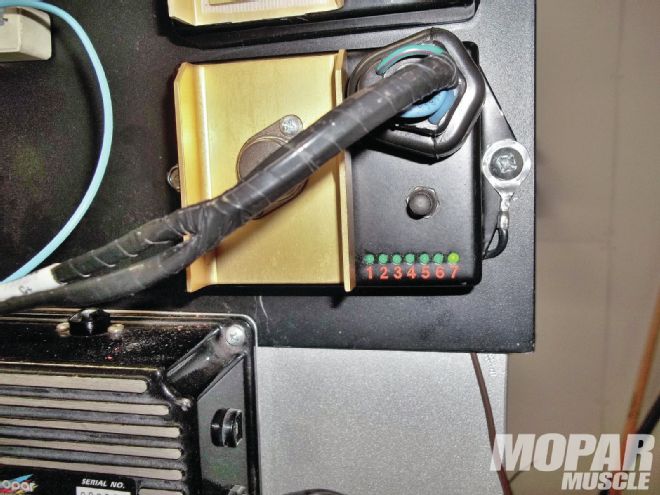 The only deviation from looking stock is the addition of the LEDs and the push button. But it looks close enough to stock and performs well enough, we can personally overlook that.
The only deviation from looking stock is the addition of the LEDs and the push button. But it looks close enough to stock and performs well enough, we can personally overlook that.
Settings:
A nice bonus is that these LED indicators also represent a digital tachometer while the engine is running: 1=1,000 rpm, 2=2,000 rpm, etc.
With the rev limiter set at 7 to make sure we would not run into issues while making power pulls, we ran the 421 through another timing loop. This time we settled on a slightly lower reading of 30 degrees total timing for our best power. With new bests of 513.8 lb-ft of torque and 487.4 horsepower, to say we were impressed is an understatement. We also noted that the timing did not retard throughout the rpm range like the Mopar boxes did, and the torque curve was the smoothest we had seen.
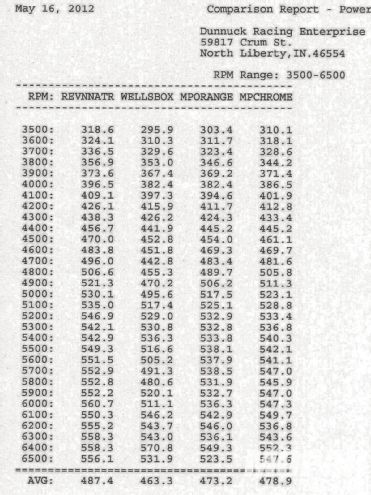 Horsepower
Horsepower
We talked to Troy at The R/T Garage and he explained a few things. The way his ignition box picks up and processes the signal from the distributor is completely different from the technology used when the Mopar boxes were designed. The older boxes did not have any sort of intelligence to modify the incoming signal and manipulate it to get the best performance. This is how he was able to get performance increases. But it does mean you may have to adjust your timing in some cases due to differences in how strong of a signal you have.